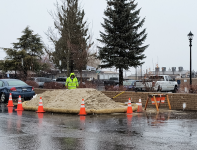
Big Bear, CA, February 21st, 2016 – As we head further into the rainy season and await more of the heavy rains predicted as part of “El Nino,” there are several steps that Californians can take to reduce the pollution that runs off cars and highways and causes increased storm water pollution. By following the tips below, drivers can help do their part to reduce pollution in our waterways during the rainy season:
Inspect and maintain your car regularly: Vehicles that are not maintained are a key source of storm water pollution. Visual inspection and routine maintenance go a long way to prevention, including:
- Fluid leaks: Prevent leakage of oil, antifreeze and other toxic auto fluids.
- Tire inflation: Improperly inflated tires lower gas mileage, increase wear and are vulnerable to blowouts. Keeping your tires properly inflated helps improve gas mileage and reduces metal particles that could end up in storm drains.
- Vehicle residue: Dirt and residue on and under a vehicle —such as brake dust—wash off onto highways when it rains. Car wash facilities remove this residue, and recycle water.
Secure loads: Trash, vegetation and other hazards from unsecured loads can fly out of truck beds. Ensure loads are properly secured with tarps and tied down.
Dispose of cigarette butts properly: Cigarette butts remain one of the top littered items along California highways. They are a fire hazard and contain toxic chemicals that can easily wash down storm drains.
Properly dispose of all trash and debris: Trash, recyclables and other debris can accumulate in vehicles, and sometimes these items fall out when people are getting in and out of vehicles, or are blown out of an open window or truck bed.
Use alternative transportation: An easy way to reduce water pollution is by carpooling, walking, riding a bike or taking public transportation. It reduces the number of cars on the highway, which reduces the amount of heavy metals from tires and brakes getting into the storm drains.
During a drought, pollution becomes even more concentrated in bodies of water because of the already existing lower water levels. Each rain event can wash pollutants off highways and into the storm drain system, ultimately impacting the quality of our water. With a little effort, and by following the tips above, we can reduce driving’s impact on our waterways.
For further information about how you can prepare for the winter and spring storm season, please visit the Governor’s storm readiness website at storms.ca.gov


